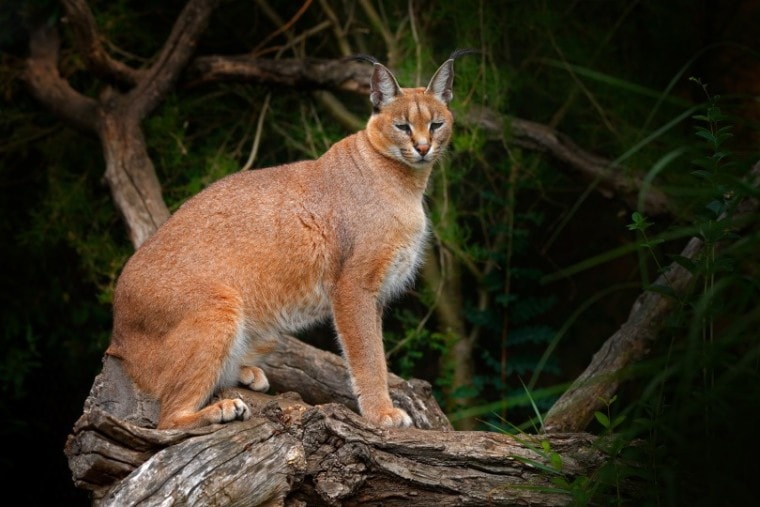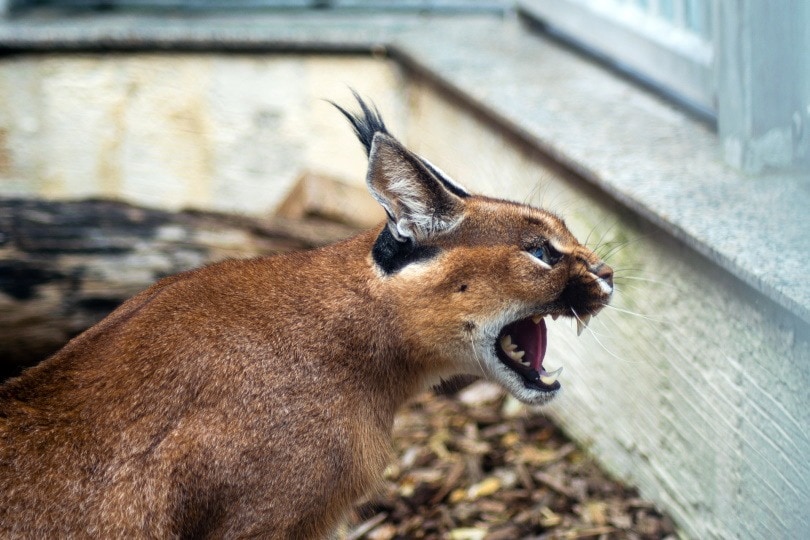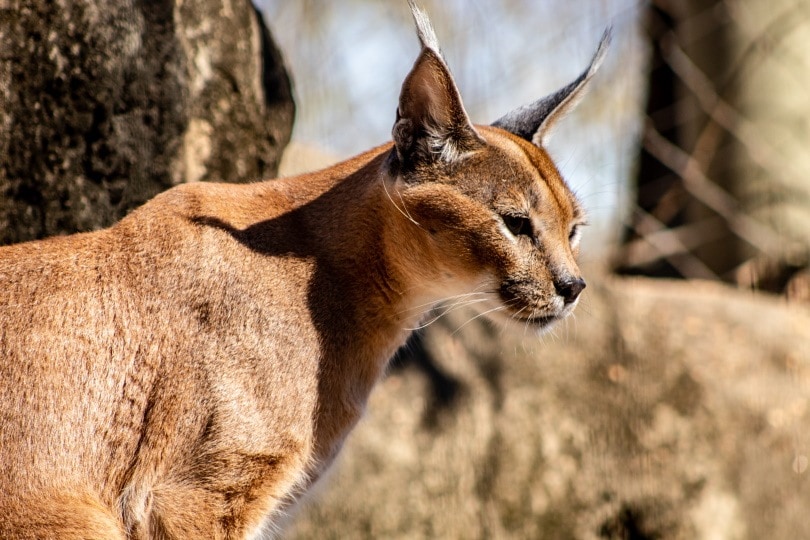
The caracal is a very distinctive large wild cat native to Africa, the Middle East, Central Asia, and dry areas in northern India and Pakistan. This cat has a sleek streamlined body, a short reddish-gold coat, long tufted black ears, and long legs. This cat gets its name from the Turkish word “karakulak” which means “black ear”.
While many people are not familiar with caracals, some people do keep them as pets but they don’t make great pets. It’s legal to keep a caracal as a pet in several states and against the law in others. For this reason, you must check with your state laws before getting one of these cats as a pet to be sure you’re allowed to keep one.
Our Disclaimer
To remain fair and neutral, we don’t encourage the practice of keeping wild cats as pets. The care and maintenance of these magnificent animals is best left to professionals and experts with considerable resources. So yes, caracals can make good pets for some people who can properly house, feed, and care for these big cats.
If you’re considering getting a caracal to keep as a pet, here is a list of facts about these large cats you should know.
1. It Looks a Lot Like a Serval
While a caracal looks a bit like a common house cat with a small spherical head and big eyes, the caracal is most like the serval in appearance. In fact, many people get these two wild cats mixed up, even though the serval has spots and the caracal doesn’t.
Caracals and servals are both medium-sized wild cats, but servals live in wetter environments than caracals that stick to arid regions.
2. It’s an Impressively Powerful Cat
A caracal can reach 3 feet in length and weigh up to 40 pounds. The male is always heftier than the female but both sexes are powerful and fast. This wild cat is large enough to care for itself and fend off foes, but not quite big enough to go head-to-head with apex predators like tigers and lions.
A caracal can leap high in the air to catch birds right out of the sky. These cats are very athletic and capable of easily climbing trees to catch their prey like leopards.

3. Their Long Ears Are Very Sensitive to Sound
The long-pricked ears of the caracal cat are always on high alert. Approximately 20 muscles are controlling the pointy ears that help the cat detect the slightest sounds.
In the wild, caracals rely on their superb hearing to survive. The long tufts at the ear tips enhance the cat’s hearing by funneling sounds into the ears.
4. They’re Meat-Eaters
The caracal is an omnivore that hunts down its prey. In the wild, the meat-eating caracal gets by on small rodents, birds, and rabbits and feasts on bigger prey, like gazelles or small antelope, occasionally. This animal knows it’s no match for a powerful zebra, leopard, or lion so it steers clear of larger animals that can do it harm.

5. It’s a Solitary Animal in the Wild
During the mating season, caracals are in pairs for obvious reasons. For the majority of the time, however, this cat is solitary and hunts alone. With its great climbing ability, a caracal can sneak up on prey and quickly snatch them up. These cats are also good diggers who will burrow into the ground to extract moles, mice, and shrews.
6. They Can Be Dangerous
A caracal is a fast runner that can outrun an ostrich and a small antelope. These territorial and primarily nocturnal cats are nothing to mess with. If you happen to corner one in the wild, it won’t hesitate to challenge you. Without hesitation, a caracal can attack if it feels threatened.

7. They Rarely Attack Humans
While it’s possible for a person to be attacked by a caracal if the animal is cornered and feeling threatened, these cats rarely attack humans. They would much prefer running away from perceived danger rather than risk their health or life over a confrontation.
Because caracal attacks are uncommon, some people think these animals can be easily tamed and cared for like domesticated house cats. Others believe that caracals are unpredictable wild animals that are best left in the wild where they belong.
8. It’s Not Cheap to Care for a Caracal
A caracal kitten may be cute and cuddly but it will grow up quickly to become a big, powerful cat. This animal cannot be allowed to roam free 24/7 in a home as it should be caged or put in a very robust pen.
The cost of a suitable cage can be well over $2,000. When you add on the annual vet check costs, vaccinations, the cost of a transport cage, and food, the price could top several thousand dollars a year to properly house and care for a caracal.

9. They Can Make Good Pets for Certain People
Caracals can make good pets for people who have a good understanding of the needs of this incredible cat species. A caracal is not a suitable pet for a novice or someone who simply wants a big cat to show off to their friends.
A caracal that’s not properly trained and cared for can be an extremely dangerous animal to keep as a pet. It takes quite a bit of sacrifice to keep a caracal as a pet as this animal needs care 7 days a week. This means vacations may need to be sacrificed as well as living space, because a caracal needs a large enclosure.
A pet caracal has to make some sacrifices too as it must adjust to living in captivity in a confined space. It also has to live without its claws that it depends on in the wild for catching and killing its prey.
Conclusion
If you feel that you’re qualified and financially able to keep a caracal as a pet, you can certainly do so if you live in a state where it’s legal. Just remember that you must be willing to invest lots of time, money, and energy toward caring for a big cat that would rather be living in its natural habitat.
See also:
Featured Image Credit: Ondrej Prosicky_, Shutterstock







